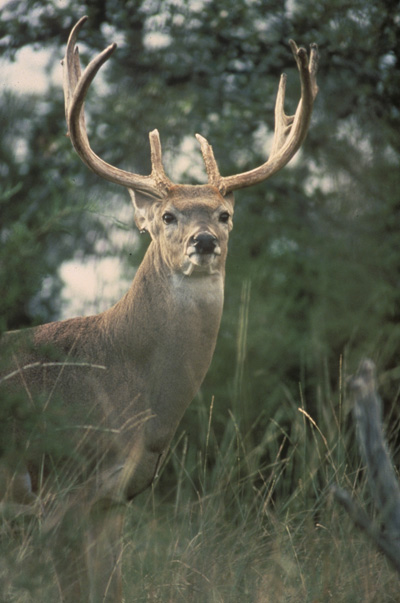by John Jefferson
Last week’s forecast covered the Hill Country and West Texas; this week, we’ll cover the rest.

Texas’ deer population is an estimated 5.5 million — up from the previous estimate of 4,000,000!
STATEWIDE, good, timely rains fell ((April, May, June) to spur vegetation growth needed for antler development, according to a report by Alan Cain, the able TPWD Whitetail Deer Program Leader. Consequently, hunters could see more bucks in the 6.5 to 8.5 – year age classes due to previously high fawn crops. Older age deer generally grow the largest antlers. In 2019, hunters harvested 846,330 deer (54% bucks; 46% antlerless).
SOUTH TEXAS BRUSH COUNTRY’s season ended very dry. Ranches with supplemental feed program fared better. Then, cool temps and good April and May rains set the stage for another good year – especially in the eastern half and south toward the Rio Grande, according to Cain. He estimates 438,000 deer with densities ranging from 15 deer/1,000 acres to 40/1,000. Sex ratio is about 2.2 does/buck. Expect more 5.5- year-old bucks, but fewer older ones. Fifty-three percent of harvested bucks last season were 4.5 years or older. Average B&C buck score last season for 5.5-plus- year-olds was 130.87. Hunter success was 77%. As usual, South Texas offers prime hunting, though lease prices are high and turnover is low.
CROSS TIMBERS is the area northeast of the Hill Country and sports the second highest deer population in Texas, just behind the hills. Deer densities vary widely from 14/1,000 acres to 88/1,000, with the highest densities occurring in an area beginning west of Waco, extending past Brownwood, and north toward Mineral Wells. Cain suggests hunters could see more 7.5 and 8.5-year-olds. Hunters took older age bucks last year, indicating a healthy population of mature bucks this season. Hunter success last year was 60%.
POST OAK SAVANNAH is a slender region running from the northern edge of the Brush Country to the Red River with a wide range of deer densities — the highest being along I-10 from San Antonio to Houston. The farther north one goes, the lower the densities, probably due to habitat fragmentation. Some big antlers have been grown in the upper area, however. The average sex ratio is 4.5 does/buck -way too high. Antler quality should be good. Hunter success was 63%.
BLACKLAND PRAIRIES border the Post Oak and are somewhat similar. Data surprisingly shows its average B&C scores were the highest for 3.5 and 4.5 – age bucks and third highest for bucks over age 5.5 – years, right behind South Texas and the Western Rolling Plains!
PINEYWOODS in East Texas has roughly 286,000 deer and densities range from 7.88 deer/1,000 acres in the southern portion to 25.25/1,000 in the center — low compared to other regions. Harvest data shows too many young bucks being taken. Overall population is increasing and hunters could see some large bucks, especially on well-managed habitats. Hunter success was 56%.
As happens every year, good bucks will be harvested in every region. This is Texas.
JJ




